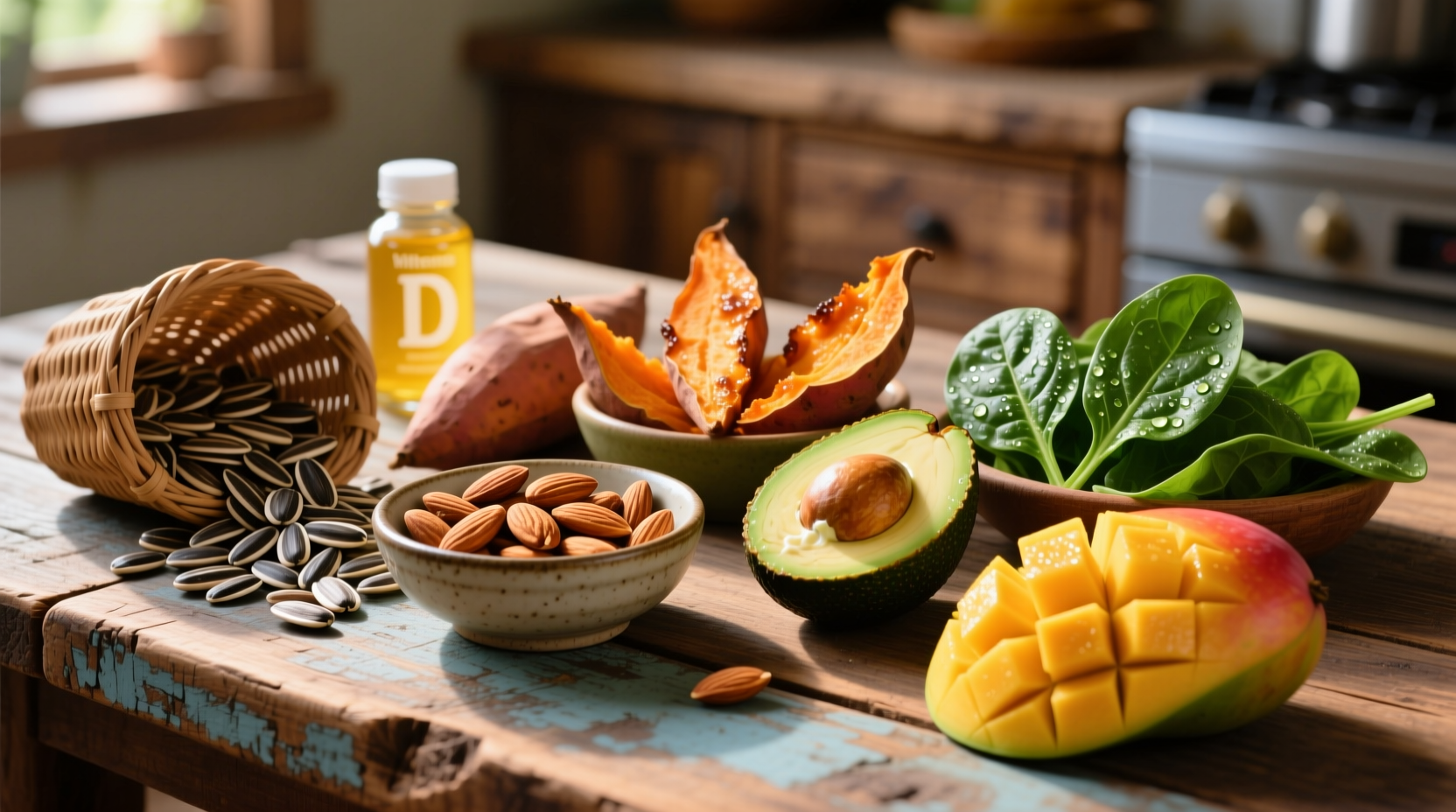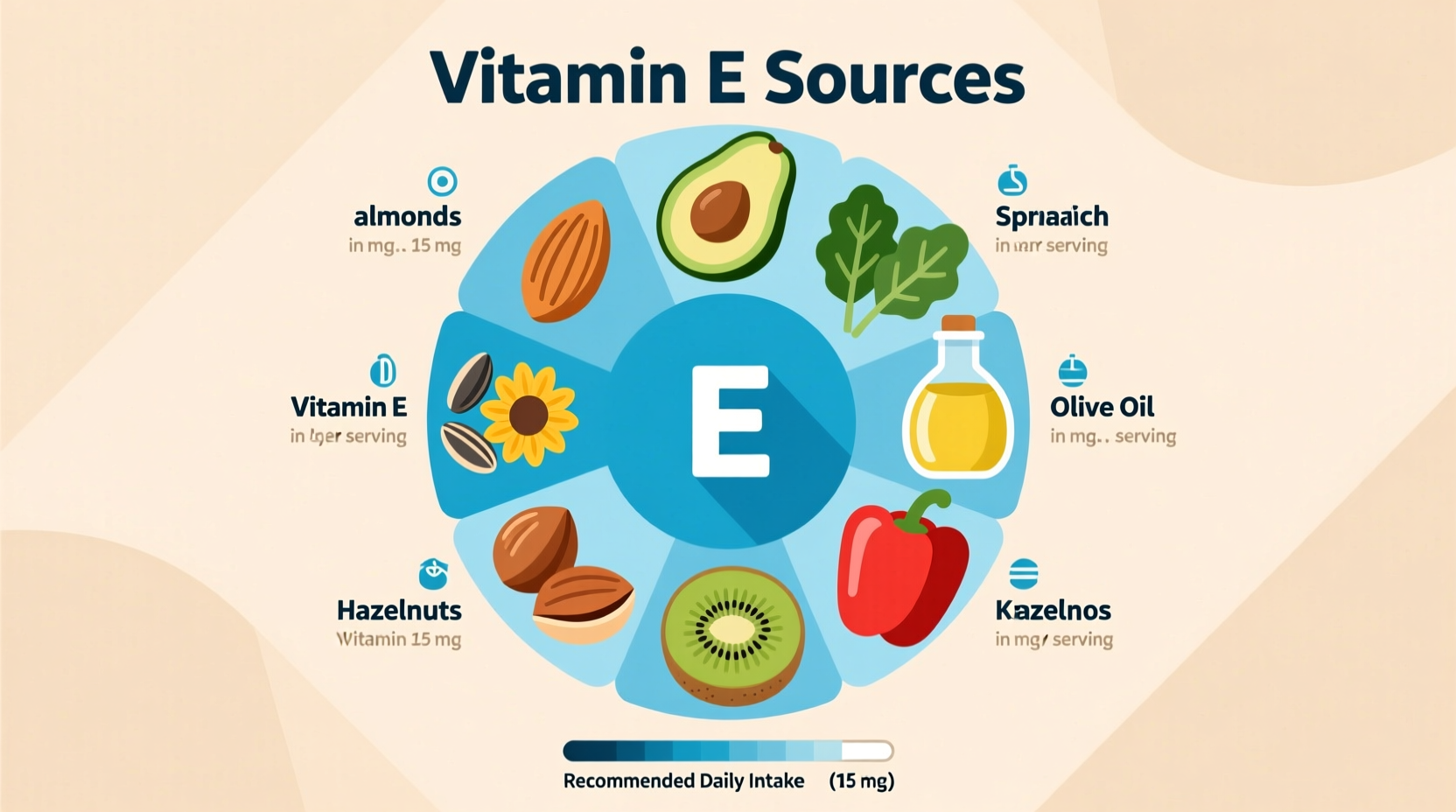Discover the top natural food sources of vitamin E: sunflower seeds (33.4mg per ounce), almonds (7.3mg per ounce), hazelnuts (4.3mg per ounce), and wheat germ oil (20.3mg per tablespoon). These powerhouse foods deliver your daily requirement of this essential antioxidant that protects cells and supports immune function.
If you're searching for "what foods have vitamin e in," you're likely looking to boost your antioxidant intake naturally. Vitamin E isn't just one compound—it's a group of eight fat-soluble antioxidants that protect your cells from damage. The good news? You don't need supplements if you incorporate the right foods into your diet. Let's explore exactly which foods deliver the most vitamin E and how to maximize absorption.
Top Vitamin E Food Sources by Category
Nuts and Seeds: The Vitamin E Powerhouses
When searching for "what foods have vitamin e in naturally," nuts and seeds should be your first stop. These portable snacks pack the highest concentrations of vitamin E per serving:
| Food | Amount | Vitamin E (mg) | % Daily Value |
|---|---|---|---|
| Sunflower seeds | 1 ounce (28g) | 33.4 | 223% |
| Almonds | 1 ounce (23 almonds) | 7.3 | 49% |
| Hazelnuts | 1 ounce (20 nuts) | 4.3 | 29% |
| Pine nuts | 1 ounce (28g) | 2.6 | 17% |
According to USDA FoodData Central, sunflower seeds contain more than double the vitamin E of any other common food source. Just one ounce provides over 200% of your daily requirement. For "what foods have vitamin e in high amounts," these should be your go-to snacks.
Vegetable Oils: Liquid Vitamin E Sources
When considering "what foods have vitamin e in cooking oils," wheat germ oil stands out as the champion. These oils work perfectly for dressings or low-heat cooking:
- Wheat germ oil: 20.3mg per tablespoon (135% DV)
- Sunflower oil: 5.6mg per tablespoon (37% DV)
- Safflower oil: 4.6mg per tablespoon (31% DV)
- Canola oil: 2.4mg per tablespoon (16% DV)
Research published in the American Journal of Clinical Nutrition confirms that vitamin E absorption increases when consumed with healthy fats. This explains why oils rank high among "what foods have vitamin e in" searches—they deliver the nutrient in its most bioavailable form.

Fruits and Vegetables: Surprising Vitamin E Sources
Many people searching for "what foods have vitamin e in fruits" are surprised to learn avocados top the list. While most fruits aren't significant sources, these stand out:
- Avocado: 2.7mg per medium fruit (18% DV)
- Mango: 1.5mg per cup (10% DV)
- Red bell pepper: 1.5mg per cup (10% DV)
- Spinach: 1.0mg per cooked cup (7% DV)
- Broccoli: 0.6mg per cooked cup (4% DV)
The National Institutes of Health notes that while vegetables contain less vitamin E than nuts, they provide additional antioxidants that work synergistically with vitamin E. This makes them valuable components when exploring "what foods have vitamin e in" for overall health.
Maximizing Vitamin E Absorption: Practical Tips
Simply knowing "what foods have vitamin e in" isn't enough—you need to optimize absorption. Vitamin E is fat-soluble, meaning your body absorbs it best when consumed with dietary fats. Here's how to get the most from your vitamin E sources:
Pairing Strategies for Better Absorption
- Add sunflower seeds to avocado toast for a vitamin E double boost
- Drizzle wheat germ oil over roasted vegetables
- Combine almond butter with apple slices
- Create salads with spinach, red bell peppers, and a sunflower oil dressing
Daily Requirements and Realistic Meal Planning
The recommended daily allowance (RDA) for vitamin E is 15mg for adults. You can easily meet this with practical combinations:
- Breakfast: Oatmeal topped with 1 oz almonds (7.3mg)
- Lunch: Spinach salad with 2 tbsp sunflower oil dressing (3.7mg)
- Snack: 1 medium avocado (2.7mg)
- Total: 13.7mg (91% of daily requirement)
Important Considerations for Vitamin E Intake
When researching "what foods have vitamin e in," consider these crucial factors that affect your actual nutrient intake:
Storage and Preparation Impact
Vitamin E degrades with heat and light exposure. The USDA notes that roasting nuts reduces vitamin E content by 15-25% compared to raw versions. For maximum retention:
- Store nuts and seeds in airtight containers in the refrigerator
- Avoid high-heat cooking with vitamin E-rich oils
- Eat fruits and vegetables raw when possible
Who Might Need More Vitamin E
Certain populations have higher vitamin E requirements:
- People with fat malabsorption disorders (cystic fibrosis, Crohn's disease)
- Those following extremely low-fat diets
- Individuals with genetic variations affecting vitamin E metabolism
The Linus Pauling Institute reports that approximately 90% of Americans don't meet the recommended vitamin E intake through diet alone. However, severe deficiency remains rare in healthy individuals consuming balanced diets.
When Supplements Might Be Necessary
While whole foods should be your primary source when exploring "what foods have vitamin e in," supplements may help certain groups:
- People with diagnosed deficiencies (confirmed by blood test)
- Those with medical conditions affecting fat absorption
- Individuals on long-term cholesterol-lowering medications
Consult your healthcare provider before starting supplements, as excessive vitamin E intake (above 1,000mg daily) may increase bleeding risk. The natural form (d-alpha-tocopherol) found in foods is generally preferred over synthetic versions (dl-alpha-tocopherol).











 浙公网安备
33010002000092号
浙公网安备
33010002000092号 浙B2-20120091-4
浙B2-20120091-4